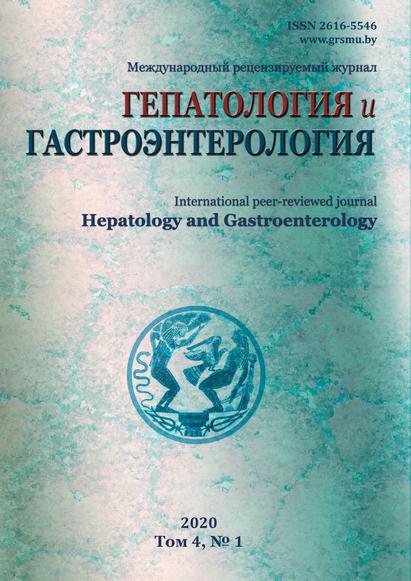CORRELATIONS BETWEEN CLINICAL, HEMATOLOGICAL, BIOCHEMICAL AND INTEGRATIVE INDICATORS AND THE DEGREE OF FIBROSIS IN PATIENTS WITH CHRONIC HEPATITIS C
Abstract
Background. Chronic hepatitis C is a liver disease that often leads to liver cirrhosis and hepatocellular carcinoma. Objective – to establish correlations between clinical, laboratory, integrative parameters and non-invasive methods for calculating liver fibrosis in patients with chronic hepatitis C. Material and methods. In 287 patients with chronic hepatitis C, who were divided into 5 groups (according to the degree of fibrosis (F)); clinical features, laboratory parameters were studied; integrative indicators, APRI (AST to Platelet Ratio Index) and FIB-4 (Fibrosis-4 Index for Liver) were calculated. Statistical analysis was carried out using the programs Microsoft Office Excel 2016, IBM SPSS Statistics with the calculation of nonparametric criteria. Results. Male patients with moderately severe fibrosis, 1b genotype and minimal activity predominated. A direct correlation was established between F (METAVIR) and FIB-4 (p <0.05), FIB-4 and APRI (p <0.05) and a tendency to correlation between F (METAVIR) and APRI. There was a direct relationship between F (METAVIR), APRI, FIB-4 and age, and body mass index (p <0.05). An inverse correlation was established between F (METAVIR), APRI, FIB-4 and platelet count; F (METAVIR) and the activity of ALT, AST, GGTP; between APRI, FIB-4 and white blood cell count, FIB-4 and red blood cell count (p <0.05). Direct connections were observed between these three indicators of fibrosis and bilirubin; F (METAVIR) and alkaline phosphatase; APRI, FIB-4 and ESR, the activity of ALT, AST and GGTP; FIB-4 and the De Ritis ratio (p <0.05). Conclusions. An increase in the degree of fibrosis is inversely correlated with the count of platelets, leukocytes and red blood cells, and is in direct proportion to ESR and bilirubin. The correlation of integrative indicators with an increase in the degree of fibrosis indicated increased intoxication associated with autoimmune process, a decrease in non-specific immunoreactivity.References
1. Gower E, Estes C, Blach S, Razavi-Shearer K, Razavi H. Global epidemiology and genotype distribution of the hepatitis C virus infection. J. Hepatol. 2014;61:S45-57. https://doi.org/10.1016/j.jhep.2014.07.027.
2. Bräu N. Pegylated Interferons and Advances in Therapy for Chronic Hepatitis C [Internet]. Available from: https://www.medscape.org/viewarticle/442365_5.
3. AASLD/IDSA HCV Guidance Panel; Chung RT, Davis GL, Jensen DM, Masur H, Saag MS, Thomas DL, Aronsohn AI, Charlton MR, Feld JJ, Fontana RJ, Ghany MG, Godofsky EW, Graham CS, Kim AY, Kiser JJ, Kottilil S, Marks KM, Martin P, Mitruka K, Morgan TR, Naggie S, Raymond D, Reau NS, Schooley RT, Sherman KE, et al. Hepatitis C guidance: AASLD-IDSA recommendations for testing, managing and treating adults infected with hepatitis C virus. Hepatology. 2015;62:932-954. https://doi.org/10.1002/hep.27950.
4. Elpek G. Cellular and molecular mechanisms in the pathogenesis of liver fibrosis: An update. World J. Gastroenterol. 2014;20(23):7260-7276. https://doi.org/10.3748/wjg.v20.i23.7260.
5. Hernandez-Gea V, Friedman SL. Pathogenesis of Liver Fibrosis: mechanisms of disease. Ann. Rev. Pathol. 2011;2:425-456. https://doi.org/10.1146/annurevpathol-011110-130246.
6. Iredale JP, Thompson A, Henderson NC. Extracellular matrix degradation in liver fi brosis. Biochim. Biophys. Acta. 2012;1832(7):876-883. https://doi.org/10.1016/j.bbadis.2012.11.002.
7. Castera L, Chan HL, Arrese M, Afdhal N, Bedossa P, Friedrich-Rust M, Han KH, Pinzani M; European Association for Study of the Liver; Asociacion Latinoamericana para el Estudio del Higado. EASL-ALEH Clinical Practice Guidelines: Non-invasive tests for evaluation of liver disease severity and prognosis. J. Hepatol. 2015;63(1):237-264. https://doi.org/10.1016/j.jhep.2015.04.006.
8. Pawlotsky JM, Negro F, Aghemo A, Berenguer M, Dalgard O, Dusheiko G, Marra F, Puoti M, Wedemeyer H; European Association for the Study of the Live. EASL Recommendations on Treatment of Hepatitis C 2018. J. Hepatol. 2018;69(2):461-511. https://doi.org/10.1016/j.jhep.2018.03.026.
9. Castera L, Sebastiani G, Le Bail B, de Ledinghen V, Couzigou P, Alberti A. Prospective comparison of two algorithms combining non-invasive methods for staging liver fibrosis in chronic hepatitis C. J. Hepatol. 2010;52(2):191-198. https://doi.org/10.1016/j.jhep.2009.11.008.
10. Godlevskyj AI, Savoljuk SI. Diagnostyka ta monitoring endotoksykozu u hirurgichnyh hvoryh [Internet]. Vinnytsia: Nova Knyga; 2015. 232 p. Available from: http://lib.inmeds.com.ua:8080/jspui/handle/lib/3321. (Ukrainian).
11. Kuznetsov PL, Borzunov VM. Sindrom jendogennoj intoksikacii v patogeneze virusnogo gepatita [Syndrome of endogenous intoxication in the pathogenesis of viral hepatitis] [Internet]. Jeksperimentalnaja i klinicheskaja gastrojenterologija [Experimental & clinical gastroenterology]. 2013;4:44-50. Available from: https://cyberleninka.ru/article/n/sindrom-endogennoy-intoksikatsiiv-patogeneze-virusnogo-gepatita. (Russian).
12. Khokhlova NI, Tolokonskaya NP, Pupyshev AB, Vasilets NM. Mnogofaktornaja ocenka jendogennoj intoksikacii u bolnyh hronicheskim virusnym gepatitom C [Multifactorial evaluation of endogenous intoxication in patients with chronic viral hepatitis C] [Internet]. Klinicheskaja laboratornaja diagnostika [Clinical Laboratory Diagnostics]. 2010;8:30-33. (Russian).


















1.png)






